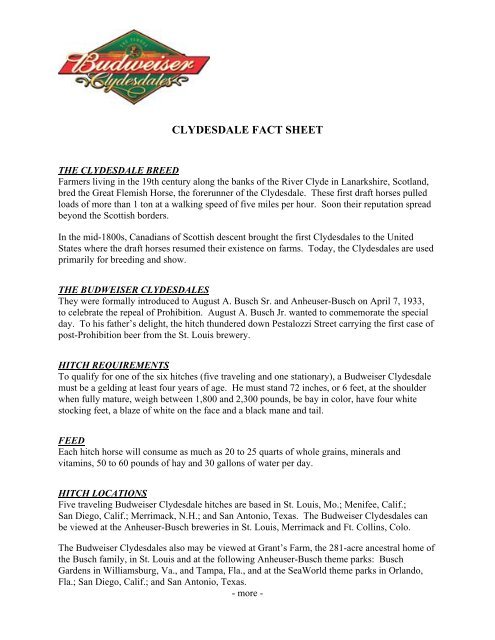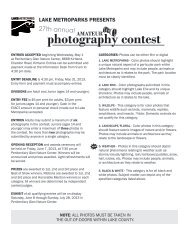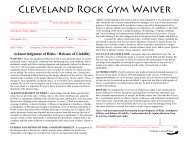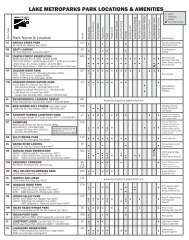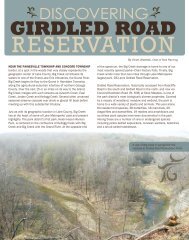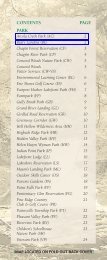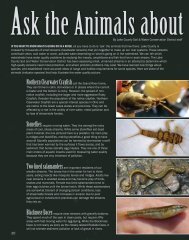CLYDESDALE FACT SHEET - Lake Metroparks
CLYDESDALE FACT SHEET - Lake Metroparks
CLYDESDALE FACT SHEET - Lake Metroparks
Create successful ePaper yourself
Turn your PDF publications into a flip-book with our unique Google optimized e-Paper software.
<strong>CLYDESDALE</strong> <strong>FACT</strong> <strong>SHEET</strong><br />
THE <strong>CLYDESDALE</strong> BREED<br />
Farmers living in the 19th century along the banks of the River Clyde in Lanarkshire, Scotland,<br />
bred the Great Flemish Horse, the forerunner of the Clydesdale. These first draft horses pulled<br />
loads of more than 1 ton at a walking speed of five miles per hour. Soon their reputation spread<br />
beyond the Scottish borders.<br />
In the mid-1800s, Canadians of Scottish descent brought the first Clydesdales to the United<br />
States where the draft horses resumed their existence on farms. Today, the Clydesdales are used<br />
primarily for breeding and show.<br />
THE BUDWEISER <strong>CLYDESDALE</strong>S<br />
They were formally introduced to August A. Busch Sr. and Anheuser-Busch on April 7, 1933,<br />
to celebrate the repeal of Prohibition. August A. Busch Jr. wanted to commemorate the special<br />
day. To his father’s delight, the hitch thundered down Pestalozzi Street carrying the first case of<br />
post-Prohibition beer from the St. Louis brewery.<br />
HITCH REQUIREMENTS<br />
To qualify for one of the six hitches (five traveling and one stationary), a Budweiser Clydesdale<br />
must be a gelding at least four years of age. He must stand 72 inches, or 6 feet, at the shoulder<br />
when fully mature, weigh between 1,800 and 2,300 pounds, be bay in color, have four white<br />
stocking feet, a blaze of white on the face and a black mane and tail.<br />
FEED<br />
Each hitch horse will consume as much as 20 to 25 quarts of whole grains, minerals and<br />
vitamins, 50 to 60 pounds of hay and 30 gallons of water per day.<br />
HITCH LOCATIONS<br />
Five traveling Budweiser Clydesdale hitches are based in St. Louis, Mo.; Menifee, Calif.;<br />
San Diego, Calif.; Merrimack, N.H.; and San Antonio, Texas. The Budweiser Clydesdales can<br />
be viewed at the Anheuser-Busch breweries in St. Louis, Merrimack and Ft. Collins, Colo.<br />
The Budweiser Clydesdales also may be viewed at Grant’s Farm, the 281-acre ancestral home of<br />
the Busch family, in St. Louis and at the following Anheuser-Busch theme parks: Busch<br />
Gardens in Williamsburg, Va., and Tampa, Fla., and at the SeaWorld theme parks in Orlando,<br />
Fla.; San Diego, Calif.; and San Antonio, Texas.<br />
- more -
Clydesdale Fact Sheet<br />
Page Two<br />
<strong>CLYDESDALE</strong> OPERATIONS<br />
Based in St. Louis, Clydesdale Operations is responsible for maintaining and scheduling the five<br />
traveling hitches. Events are typically sponsored in part by the local Anheuser-Busch wholesalers<br />
and thousands of requests for the “gentle giants” are received each year. Each request is evaluated<br />
on the type of event, dates, history of appearances in that particular area and other input from<br />
Anheuser-Busch management representatives.<br />
STABLES<br />
The official home of the Budweiser Clydesdales is an ornate brick and stained-glass stable built in<br />
1885 on the historic 100-acre Anheuser-Busch brewery complex in St. Louis. The building is one<br />
of three located on the brewery grounds that are registered as historic landmarks by the federal<br />
government.<br />
HANDLERS<br />
Expert grooms travel on the road with the hitch. They are on the road at least 10 months every<br />
year. When necessary, one handler has night duty to provide round-the-clock care for the horses,<br />
ensuring their safety and comfort.<br />
TRANSPORT<br />
Ten horses, the famous red, white and gold beer wagon and other essential equipment are<br />
transported in three 50-foot tractor-trailers. Cameras in the trailers (with monitors in the cabs)<br />
enable the drivers to keep a watchful eye on their precious cargo during transport. The team stops<br />
each night at local stables so the “gentle giants” can rest. Air-cushion suspension and thick rubber<br />
flooring in the trailers ease the rigors of traveling.<br />
DRIVERS<br />
Driving the 12 tons of wagon and horses requires quite a bit of strength and skill. The 40 pounds of<br />
reins the driver holds, plus the tension of the reins, equals 75 pounds. All hitch drivers are put<br />
through a rigorous training period before they are given the reins.<br />
HARNESS<br />
Each harness and collar weighs approximately 130 pounds. The harness is handcrafted from brass<br />
and leather. Pure linen thread is used for the stitching. The harness is made to fit any horse, but the<br />
collars come in different sizes and must be individually fitted like a suit of clothes.<br />
NAMES<br />
Duke, Captain, Mark and Bud are just a few of the names given to the Budweiser Clydesdales.<br />
Names are kept short to make it easier for the driver to give commands to the horses during a<br />
performance.<br />
- more -
Clydesdale Fact Sheet<br />
Page Three<br />
HORSESHOES<br />
Clydesdale horseshoes measure more than 20 inches from end to end and weigh about<br />
5 pounds – more than twice as long and five times as heavy as the shoe worn by a riding<br />
horse. A horse’s hoof is made of a nerveless, horn-like substance similar to the human<br />
fingernail, so being fitted for shoes affects the animal no more than a manicure affects<br />
people.<br />
WAGON<br />
Turn-of-the-century beer wagons have been meticulously restored and are kept in excellent<br />
repair. The wagons are equipped with two braking systems: a hydraulic pedal device that<br />
slows the vehicle for turns and descents down hills, and a hand brake that locks the rear<br />
wheels when the wagon is at a halt.<br />
DALMATIANS<br />
Dalmatians have traveled with the Clydesdale hitch since the 1950s. The Dalmatian breed<br />
long has been associated with horses and valued for their speed, endurance and dependable<br />
nature. Dalmatians were known as coach dogs, because they ran between the wheels of<br />
coaches or carriages and were companions to the horses. Today, the Dalmatians are perched<br />
atop the wagon, seated next to the driver.<br />
# # #


